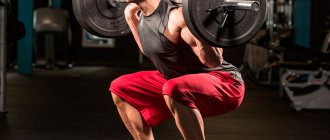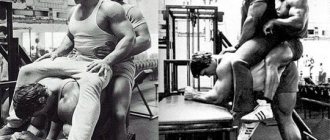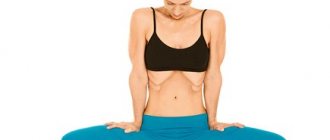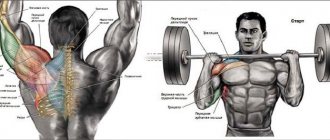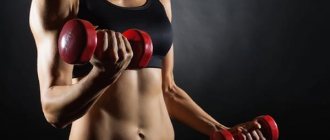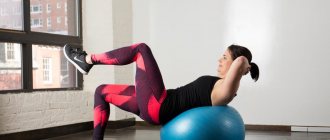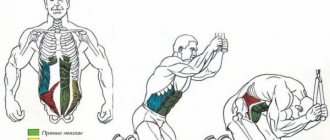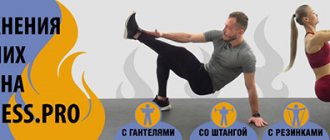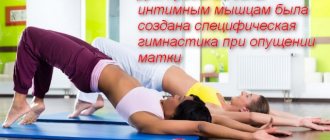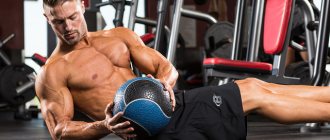Reverse crunches are one of the most effective exercises for pumping up the lower abdominal muscles. The technique of this type of twisting is quite simple and completely accessible to everyone, including beginner athletes. However, to achieve the best results from the training, you need to know some nuances and secrets.
Among the gigantic number of different exercises for working out the abs, one can note only a few truly effective ones, which include twisting, hanging leg raises, and the vacuum exercise. Direct crunches are analyzed in detail in a separate article; in the current article we will talk about reverse abdominal crunches.
Let's look at the mechanics of the exercise's effect on the abdominal muscles, the correct technique and recommendations.
What muscles work?
The reverse is crunches, in which the lower body (pelvis) twists in relation to the upper body. When performing this exercise, the main work is performed by the rectus abdominis muscle, especially its lower section. Additionally, the following muscles are also loaded:
- iliopsoas;
- latissimus dorsi muscles;
- rear delta;
- synergists - iliopsoas, pectineus, sartorius, adductor and oblique muscles;
- stabilizer muscles - quadriceps, teres major, rectus femoris, triceps.
With reverse crunches, the abdominal muscles interact with the hip flexor muscles, which additionally allows you to develop acceleration from the starting position, which will help in many team sports (football, tennis, badminton), martial arts and athletics.
Execution technique
You can perform reverse crunches on the floor, with a fitness mat underneath, or on a horizontal bench. In any case, there should be a support near the head that you can clasp with your hands. Thanks to this, it will be possible to fix the upper body and do crunches precisely due to the upward movement of the hips. The edge of a bench, sofa, radiator, etc. can act as a support.
In general, the intensity of the load on the abdominal muscles is determined by the position of the arms and legs. The further the heels are located from the pelvis, and the palms from the head, the harder it is to perform the exercise. Therefore, the closer the legs are to the pelvis, the easier it is to twist. Due to this, you can adjust the level of load as the body is trained.
The step-by-step execution of reverse twists is as follows:
- Lie down on a bench or the floor, spread your arms behind your head and clasp a support with them, for example, the edge of the bench near your forehead. You can also place your hands under your buttocks or spread them along your body.
- Bend your knees and raise your hips to a position perpendicular to the floor, that is, they should form a 90-degree angle with the lower leg and the floor.
- Slowly raise your legs, bringing them as close to your body as possible, with your knees moving towards your chest. The angle of the knees should be maintained throughout the entire movement.
- When you reach the top point, slowly exhale and hold in this position for 0.5-1 second, trying to feel the contraction of the abdominal muscles as much as possible. You can mentally count to three.
- Inhaling, slowly return to the starting position without touching the floor with your feet to maintain tension in the abdominal muscles. It is strictly forbidden to throw your feet on the floor, since in this case the exercise loses all its meaning.
- Repeat the exercise the required number of times.
The main goal of the exercise is not just to lift the legs and pelvis, but to twist them towards the chest. When performing crunches correctly, you can feel the rectus muscle working.
Pros and cons of the exercise
The main advantages of reverse abdominal crunches:
- The exercise works the entire abs (with an emphasis on the lower part).
- Safety for the spine.
- Suitable for athletes with any level of physical fitness.
- You can perform reverse crunches on the floor, bench, or any other flat surface.
- Prevention of umbilical and inguinal hernias.
- Maintaining the natural position of internal organs.
The exercise has only one drawback - the need to concentrate tension on the press. This will allow you to focus the load on the desired area and increase the effectiveness of reverse crunches.
Common Mistakes
In order to correctly master the technique of performing reverse crunches, you should pay attention to the most common mistakes that beginners make:
- Do not strain the pelvis . Many people simply raise their legs to the body, and then lower them, without including the pelvis in the work. This is a gross mistake, since the function of the press anatomically is to raise the pelvis, and not the legs. In this regard, when performing the exercise, you need to focus on the work of the pelvis. It needs to be raised and slightly rounded at the top point.
- They lower their legs sharply . This must be done smoothly so that the knees maintain a right angle throughout the entire trajectory of ascent and descent.
- Arch the lumbar back . This should not be allowed, otherwise you can simply strain your back. It should be pressed tightly to the floor or inclined bench.
- Perform oblique twists . They raise their hips to the sides, and this position of the body can harm the spine and even cause injury. To prevent this, the pelvis should be twisted only in a vertical plane.
- They tear off the head . This should not be allowed, otherwise you may injure your neck. To keep your head on the floor or bench, you don't need to look at your feet all the time. You can simply look up.
- Rotate your shoulders and bring your knees closer to one or the other shoulder . In this case, the risk of curvature of the spine increases at the time of lifting the pelvis, and the intervertebral discs are already in an extremely unstable position relative to each other, being under pressure from the weight of the legs and pelvis raised upward. In order not to roll your shoulders, you need to perform all lifts and twists strictly vertically.
Adviсe
A few recommendations for getting maximum results from abdominal crunches:
- Perform the exercise slowly, feeling the tension in your abdominal muscles.
- At the top point of the amplitude, while holding the position for 1 second, you can additionally squeeze (tighten) the abdominal muscles.
- Lower your legs down smoothly, do not do it suddenly. The knees should form a right angle throughout the entire lifting and lowering trajectory.
- Keep your hands on the floor at all times, or hold on to the edges of the bench. If you perform the exercise on the floor, you should not lift them off the floor.
- Watch your lumbar back, press your lower back to the floor and do not allow it to arch.
- Exhalation is done with effort (straining), and inhalation is done with stretching (lowering).
- It is recommended to perform 3-4 approaches, with the number of repetitions, as already mentioned, from 10 to 20.
- Avoid doing oblique crunches by raising your hips to the sides. This position of the body will negatively affect the spine, which may lead to the risk of injury. Twist your pelvis only in a vertical plane.
- Do not lift your head from the bench (floor), you do not need to look at your feet all the time.
You can perform abdominal exercises both before and at the end of the main workout. It is recommended to perform reverse crunches after performing traditional crunches or hanging leg raises on the bar.
Don't make reverse crunches the centerpiece of your ab workout. The development of the abdominal muscles will be more complete as a result of performing several exercises. Following the above tips will help you achieve excellent results in a short time.
Contraindications
There are contraindications to reverse crunches. Which include previous hernias and spinal injuries. In addition, this type of twisting should not be performed during exacerbation of diseases of the gastrointestinal tract, especially ulcers and pancreatitis.
Options:
In addition to the traditional embodiment, the following variations are possible:
- reverse crunches while lying on an incline;
- in a supine position, lying on a fitball, holding the handles of the exercise machine or a bench;
- on the floor with the ball between your legs.
Conclusion
Use reverse abdominal crunches in your abdominal muscle training, this will give them relief and, after a while, achieve the desired abs. Combine this exercise with other abdominal exercises and use methods to increase the intensity of the load.
Recommendations
To achieve maximum results from crunches, consider the following tips:
- Perform the exercise at maximum amplitude, since it is more effective with strong contractions of the abdominal muscles.
- In the initial stages of training, if you have difficulty lifting your legs, not to mention twisting your pelvis, you can bend your knees, leaving a small distance from the pelvis. This will lighten the load, because the closer the legs are to the chest, the easier it is to do the twisting. As your legs become trained, you should gradually straighten them.
- When performing the exercise, keep your hands on the floor or on a support, but not in the air.
- Do the crunch slowly to feel the tension in your abdominal muscles. When you reach the top point, you can further tense your muscles while holding the position for 0.5-1 second.
- Exhale when strengthening (twisting), and inhale when stretching (lowering).
- Pull your knees toward your head rather than toward your chest, which will help improve flexibility in the lumbar region. In turn, this will help improve the range of motion and stretch the lower back muscles.
- Do not lower your feet to the floor during the entire approach, as this will activate the muscles responsible for hip flexion and reduce the load on the abs.
- Hold your breath in the abdominal area to tighten the muscles and reduce the risk of injury by keeping your spine in a safe position.
By following the tips listed above, you can significantly increase the strength of your abdominal muscles, as well as more actively work your oblique abdominal muscles. If you combine training with a diet, you will be able to quickly reduce body fat and get the desired relief.
Let's sum it up
Reverse crunches are suitable for both men and women
Reverse crunches perfectly complement all other abdominal exercises. They are suitable as an independent basic exercise for beginners and as a warm-up or pump for experienced athletes.
It is incorrect to believe that such crunches allow you to strain only the lower abdomen, since the load is distributed across all abdominal muscles.
The technique for performing this movement is more strict, which is associated with a significant load on the spine. Therefore, many of the options available for simple crunches are not available for reverse crunches.
However, they can also be diversified, complicating or simplifying the movement. The main thing is to monitor the position of the legs, not to bend the spine and put pressure on the abs throughout the entire execution.
If you want to share your opinion or have any questions about this exercise, you can write them below in the comments. We will definitely answer and add the necessary information to the article.
Sports doctor, nutritionist, rehabilitation specialist
Provides general consultations on nutrition, selection of a diet for pregnant women, weight correction, selection of nutrition for exhaustion, selection of nutrition for obesity, selection of an individual diet and therapeutic nutrition. Also specializes in modern methods of functional testing in sports; athlete recovery.
Other authors
Different variants
After mastering the classic reverse crunch, you can practice different interpretations of this exercise:
- With straight legs . Unlike classic reverse crunches, in this exercise you need to keep your legs straight throughout the entire movement. So, in the initial position, you need to keep your legs suspended, and when you lift your lower back off the floor or bench, push them up, trying to reach the “ceiling” with your feet, but under no circumstances put your legs on your face.
- On a positive incline bench . You need to perform classic reverse crunches on a bench, spreading your arms behind your head and grabbing its upper edges. Thanks to the inclined position of the body, it is possible to perform twisting in a greater amplitude and increase the load on the target muscles.
- Sitting on a chair . It is practiced in a sitting position, so it can be performed even in an office environment. The reverse twist is performed in this way: sit on a chair and simultaneously pull both knees towards your shoulders, tensing your abdominal muscles. To enhance the effectiveness of the exercise, you should make a counter movement with your body towards your knees, slightly leaning forward.
- On fitball . The exercise is performed on a gymnastic ball - fitball. You need to kneel on it, lean forward and rest your outstretched palms on the floor, keeping your body weight on the ball, which should be at hip level. Keep your body straight. Begin to pull the fitball towards your chest, rolling forward with the help of your knees. Then slowly return to the starting position. When twisting, you need to straighten your back and chest as much as possible, without spreading your shoulder blades.
- With a fitball between your legs . In this case, you need to lie with your back on the floor and spread your arms along your body. Then hold the ball between your feet. Keeping your legs as straight as possible, lift the ball up toward the ceiling, twisting and lifting your lower back. Slowly return to the starting position.
Making classes more difficult
Complications are often used in athletic gymnastics, cross-fit and fitness.
An exercise such as incline crunches can be made more difficult as the abdominal muscles adapt to the load over time. Therefore, you can train your abs every other day, and as a complication, use adding weight and changing the angle of the bench.
To select weights, use any objects that can be held in your hands; this could be a barbell or dumbbell, a medicine ball, a kettlebell, or a stack of books if training takes place at home.
How to choose the optimal weight. The weight of the weight can be selected using a simple test; you need to do 20-30 crunches with weights; if you do not feel a burning sensation in the muscles, then you can add weight.
The angle of inclination can make it more difficult to perform crunches by increasing the amplitude; the lower your starting position, the more difficult the repetitions are for you.
Professionals use a wide angle and well-chosen weights.
Training scheme
Reverse crunches should be included in your abdominal workout as a basic exercise. Before performing them, you should definitely do a 5-minute general warm-up. Since the lumbar region is passively involved in the exercise, you should first warm it up using classic hyperextensions.
One workout should include 3-4 sets of 10-20 repetitions. After performing reverse crunches, you can perform exercises that focus more on the upper abs and obliques.
Several different abdominal exercises combined with reverse crunches will help you develop your abdominal muscles more fully.
Subtleties of reverse twisting
The idea that there are upper and lower abdominal muscles is a little misleading. In fact, only one muscle is responsible for the relief of the abdomen - the rectus muscle. This is a paired, flat and rather long muscle, wider at the top, tapering downwards and located next to the linea alba. The rectus muscle is divided into sections by tendons, which form the well-known “abs.” Therefore, it makes no sense to train only the upper or lower abs; it is necessary to work on the entire rectus abdominis muscle.
Rectus abdominis muscle
It has been established that the wide part of the rectus muscle responds better to loads and quickly acquires the desired relief.
Reverse crunches have a greater impact on the lower part of the muscle, so you can achieve a uniform formation of the abdominal relief
If the technique of reverse crunches is violated, you may not achieve the desired result and cause painful sensations that are unacceptable during training. Therefore, it is important to follow certain rules:
- During exercise, the lumbar region should be in contact with the floor - violation of this rule will cause pain in the back.
- The pace should be slow and the movements should be smooth - this will ensure the best result.
- While holding your legs in the upper position, you need to tense the rectus abdominis muscle, and the angle in your knees should always be straight, at any stage of the exercise.
- to perform 3-4 approaches , and each should consist of 15-20 reverse twisting exercises.
- Reverse crunches are recommended at the end of complex classes. At this moment, the abdominal muscles will be sufficiently warmed up, which means they will respond better to physical activity.
It is undesirable to neglect other types of crunches: only with varied loads can you get a truly attractive abdominal contour .
It is important to monitor your breathing during exercise: inhalation is for relaxation, and exhalation is for strengthening.

